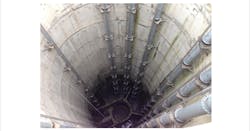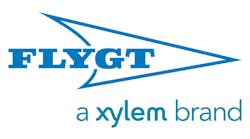Designed to reduce environmental impacts resulting from combined sewer overflows (CSOs) in Columbus, Ohio, the Olentangy-Scioto-Interceptor-Sewer Augmentation Relief Sewer (OARS) will intercept wet weather overflows that currently empty into the Scioto River and instead carry the flows to the city’s Jackson Pike and Southerly wastewater treatment plants.
The overall length of the OARS tunnel is just less than four-and-a-half miles, and it includes three relief structures that divert wet weather combined sewer flow to the OARS tunnel. It is sized to provide adequate conveyance capacity through 2047 for all storms contained within the typical year as defined by the city. The OARS tunnel ends at the OARS Diversion Structure just north of the Jackson Pike wastewater treatment plant, which serves as the pump station wet well.
Scope
Among the most interesting components of the OARS project is a 215-ft-deep, 60-million-gal-per-day (mgd)-capacity pumping system and a 185-ft-deep screening system. The OARS pumping system consists of multiple pumps that can handle enough flow to dewater the tunnel within two days of a large flow event. The difficulty with the deep pumping system on this project is that the static head condition varies from as much as 210 ft when the tunnel is empty to as little as 15 ft when the tunnel and shafts are full.
Solution
The response to this pumping challenge was the installation of four Flygt Model CP3351.995 800-hp, 4,160-VDC, 15-mgd adjustable-speed pumps that handle the majority of the work at the deep tunnel level; and two Flygt Model CP3531.960 450-hp, 4,160-VDC, 20-mgd adjustable-speed pumps to handle the shaft dewatering. Two grit pumps—Flygt Model NP3301.095 105-hp, 460-VDC—and one Flygt Model NP3306.715 100-hp, 460-VDC, were also installed.
The best solution from an investment and operational perspective in cases such as these is often to install submersible pumps in a circular wet well design.
The Phase 1 contractor utilized slurry panels to provide a watertight support of the excavation system in the top 115 ft, soft ground portion of the shaft. The lower 100 ft of excavation was in rock. It was first pre-grouted, and then drilling and blasting were used to excavate to the bottom of the shaft. A finishing wall of concrete that was 2 ft thick in the rock section and 3 ft thick in the soil section was installed to create a permanent watertight wet well shaft. The 50-ft-tall baffle wall system was constructed within the shaft. Upper flow-diversion channels were built around the top portion of the shaft. The structural top of the shaft was finished with a 113-ft-by-83-ft concrete pad with a 42-in. parapet wall around the opening of the deep shaft.
The Phase 2 contractor then took over and installed all the piping and supports. Installing the piping support system was difficult in that it required everything to be lined up perfectly to allow for 10-ft-tall pump installation and retrieval along straight guide rails over the 215-ft depth. A great deal of coordination on the shop drawings was required to ensure adequate space for everything to fit just right.
Results
Wet testing of the pumping systems was completed in April 2017, and the system has been handling live flows since early July. Faced with a huge CSO problem, Columbus has combined sound engineering with state-of- the-art equipment in the OARS to deliver a solution to CSO issues for decades to come.
Editor's Note: Scranton Gillette Communications and the SGC Water Group are not liable for the accuracy, efficacy and validity of the claims made in this piece. The views expressed in this content do not reflect the position of the editorial teams of Water & Wastes Digest, Water Quality Products and Storm Water Solutions.


